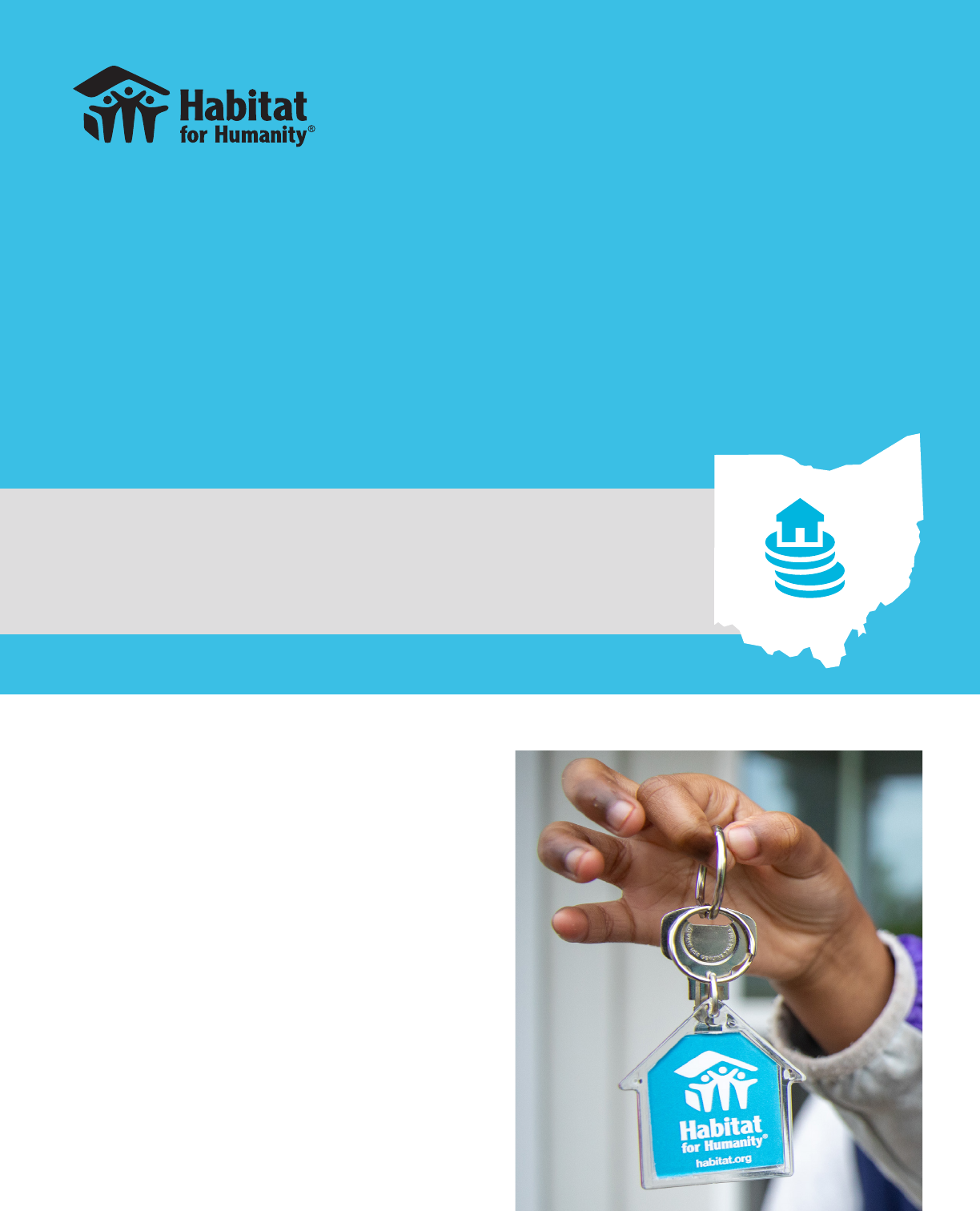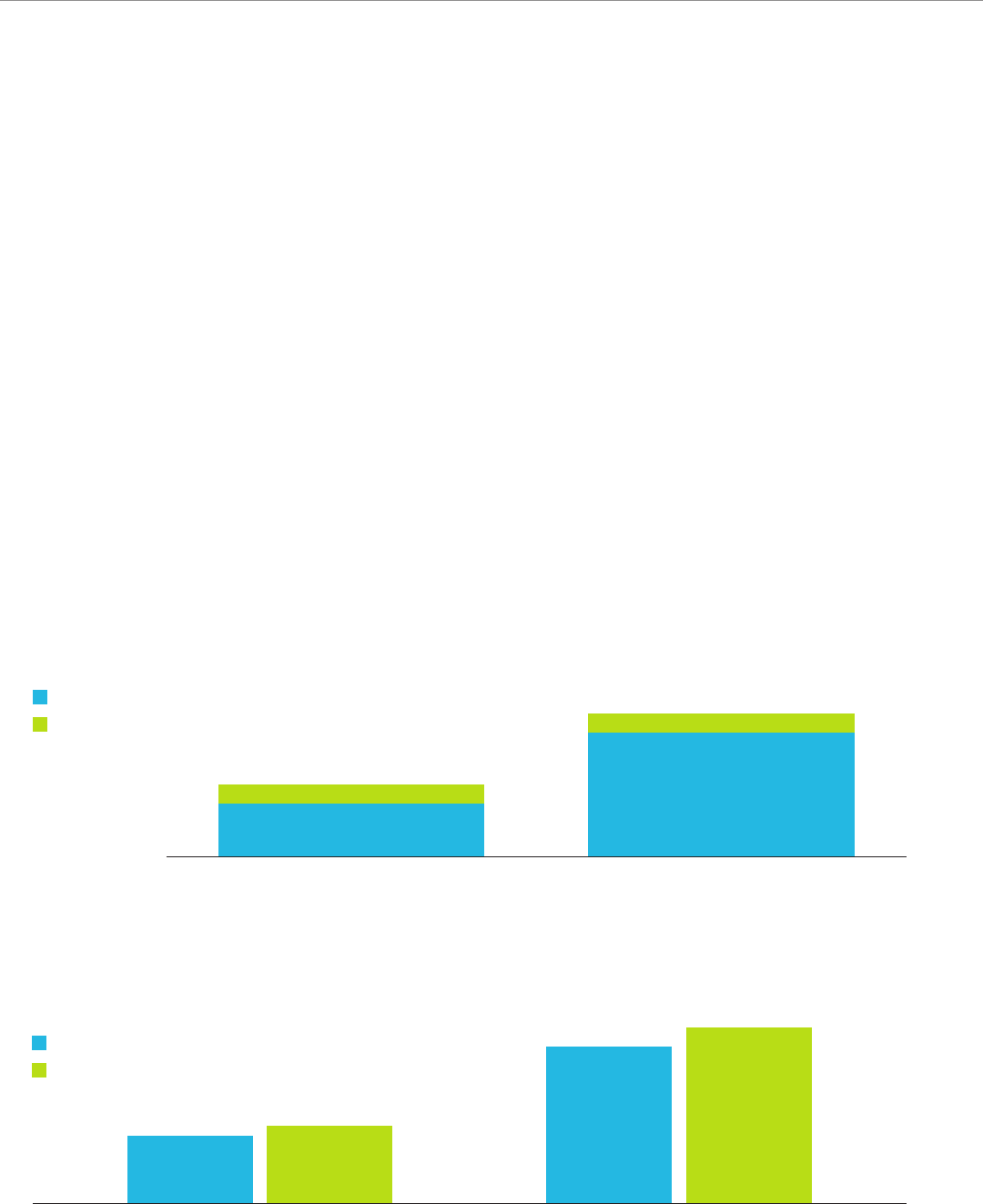
Homeownership
Builds Wealth
Introduction
Homeownership can be a catalyst to wealth building,
especially among households with low incomes who hold
most of their wealth in their homes. Homeownership creates
wealth in two ways:
1. Appreciation in the home’s value.
2. Equity accumulated as homeowners pay down their
mortgages (also known as “forced savings”).
Home value appreciation helps homeowners build wealth
by enabling them to realize greater proceeds if they sell
the home or borrow against the additional equity. Housing
stability is particularly important for wealth accumulation,
and the length of homeownership is significantly and
positively associated with household net wealth.
1
In addition,
owning a home promotes intergenerational homeownership
and wealth building. See the full evidence brief on how
homeownership contributes to wealth building here.
A study of Habitat for Humanity
homeowners in Ohio

1 HABITAT FOR HUMANITY INTERNATIONAL A STUDY OF HABITAT FOR HUMANITY HOMEOWNERS IN OHIO
Barriers to wealth building
through homeownership
Gender, racial and ethnic gaps persist in wealth building
in the U.S., including wealth built through homeownership.
Because of market forces and negotiating power, single
men earn 7.9% more annually on their housing investment
than single women. Single women typically pay 1-2% more
for homes, on average, and then sell for 2-3% less than
single men, leading to an approximate loss of $1,800 (in
2022 dollars) annually for single women compared with
single men.
2
Black and Hispanic/Latino households accumulate
less wealth and equity in their homes, on average, than
white households. Barriers contributing to this include:
• Having higher mortgage rates.
• Purchasing lower-valued and slowly appreciating
homes.
• Having higher property taxes.
3
Based on these factors, Black and Hispanic/Latino
households are also less likely to sustain homeownership
over time. One analysis of households between 1976 and
1993 found that less than half of homeowners of color
with low incomes remained homeowners within four years
of purchasing their homes, compared with 60% of white
homeowners with low incomes, 65% of white households
with middle incomes, and 85% of white households with
high incomes.
4
How Habitat helps households
with lower incomes
In the U.S., Habitat for Humanity focuses its services
on homebuyers and homeowners who earn between
30% and 80% of the area median income, or AMI. The
U.S. Department of Housing and Urban Development
calculates AMI for each geographic area annually based
on the midpoint of a region’s (e.g., metropolitan area and
non-metropolitan counties) family income distribution
with adjustments based on family size. For a family of
four living in the Cincinnati, Ohio, area, for instance, this
translates to gross annual incomes ranging from $28,650
to $76,400 in 2022.
5
Habitat oers financial and educational assistance
to homebuyers to ensure that they pay an aordable
mortgage and can thus more easily build wealth. This
assistance typically includes:
• A primary zero- or low-interest loan equivalent to no
more than 30% of the homebuyer’s income.
• Repayable or forgivable secondary loans that may be
contingent on the homebuyer remaining in the home
for a specified period.
• Pre-purchase homeownership classes to prepare
buyers for a successful homeownership journey.

Appreciation
Year A Year C Year B
($)
Down payment
Payment
Debt forgiven
Debt
Housing equity was calculated at 10 and 30 years for this
study. The Habitat aliates included in the study’s sample
oered zero-interest loans with terms no longer than 30
years. The study calculates housing appreciation from the
dierence between the purchase price and the current
value of the home. The study estimates the current value
of the home by inflating the purchase price of the home to
2021 dollars using the Midwest consumer price index and
then projecting the purchase price at 10 and 30 years using
county-level averages of the Federal Housing Finance
Agency House Price Index, or FHFA HPI.
6
Why Ohio?
Ohio is the seventh most populous state in the U.S., with
11.8 million residents.
7
Approximately 80% of the population
resides in urban areas, with the remaining 20% residing in
rural areas. According to the U.S. Census Bureau, in 2020,
approximately 75.9% of the state’s population was white
only, 12.3% was Black only, 2.5% was Asian only, and the
remaining 4.8% were American Indian/Alaska Native, Native
Hawaiian/other Pacific Islander, other, or a combination of
dierent races. Approximately 4% of the state’s population
were of Hispanic/Latino origin.
8
As of 2020, approximately
66.3% of Ohioans owned their home. The homeownership
rate has yet to recover from the eects of the Great
Recession, having peaked at 73.3% in 2005.
9
Ohio can be
characterized as a unique state where some cities have
experienced economic and housing booms while “Rust
Belt” cities that historically relied on U.S. steel production
and other heavy industries, with Cleveland and Dayton
fueling much of the growth.
10
Most recently, Intel announced
the building of a chip plant near Columbus, further
contributing to the economic development in this area.
11
Habitat for Humanity in Ohio
• Forty-three Habitat aliates operate within Ohio,
and all oer zero-interest-rate loans to homebuyers
with low incomes. Aliates seek households earning
between 30% and 80% of AMI and having front-end
and back-end debt-to-income, or DTI, ratios
12
of 30%
and 43%, respectively.
In 2021, Habitat for Humanity International conducted
a pilot study in Ohio to understand the extent to which
Habitat helps homeowners build wealth and how wealth
building varies by homeowner, aliate and market
characteristics. This study addresses two questions:
1. To what extent do Habitat homeowners build wealth?
2. To what extent does accumulated wealth vary by
homeowner, aliate and market characteristics?
Lessons learned from this pilot study are being used to
inform a national impact study.
How wealth is calculated
This study defines wealth accumulated as the sum of
mortgage payments, home value appreciation and any
housing debt forgiven. Figure 1 depicts a typical debt
structure from the time of home purchase (Year A) to
the time the home is paid o (Year B). The homeowner
leverages debt and contributes a down payment to
purchase the home at Year A. As the homeowner makes
mortgage payments and debt is forgiven, starting in
Year C, the homeowner begins to increase the equity in
the home. Depending on market trends and the home’s
location, the home’s value rises over time, also known as
appreciation. The combination of debt reduction, mortgage
payments, amount of the down payment, and home value
appreciation constitutes a homeowner’s equity or wealth
by Year B.
HABITAT FOR HUMANITY INTERNATIONAL A STUDY OF HABITAT FOR HUMANITY HOMEOWNERS IN OHIO 2
The Ohio wealth building study
Figure 1: Wealth accumulation model
HOW DOES HOMEOWNERSHIP CONTRIBUTE TO SOCIAL AND
CIVIC ENGAGEMENT?

• Ohio aliates vary in stang capacity. Based on the
survey responses from aliates, almost one-third of
aliates are run entirely by volunteers. The average
aliate, however, is staed by five full-time employees
and 1.4 part-time employees.
• Over 70% of aliates oer pre- and/or post-purchase
support to homebuyers. The most prevalent forms
of homebuyer support include financial education,
lending practices and homeownership classes.
Study approach
Data sources used to understand homebuyer, aliate,
and market characteristics
In order to understand homebuyer and aliate
characteristics, a combination of data sources were used.
HFHI’s Aliate Statistical Report, or ASR, was used
to determine the number of mortgages held by each
aliate and the delinquency rate. Aliates were asked
to review their Housing Production Report, or HPR,
address portfolio to validate their data, correct incomplete
addresses, and provide updated homeowner names and
demographics. Mortgage data was purchased from Black
Knight Inc., an integrated technology, data and analytics
firm, and validated by Ohio aliates. Participating aliates
also completed an aliate programs and practices
survey to understand intake, homebuyer support,
construction and financing processes. In addition, data
from the FHFA HPI and the consumer price index were
used to calculate wealth at 10 and 30 years, and data
related to poverty rates, changes in population, income
and housing occupancy from the American Community
Survey, or ACS, were used to understand characteristics
of the local housing market.
3 HABITAT FOR HUMANITY INTERNATIONAL A STUDY OF HABITAT FOR HUMANITY HOMEOWNERS IN OHIO
Sample
The study’s sample consists of all homeowners who
purchased a home from an Ohio-based Habitat aliate
between 2010 and 2021, and the sample period extends
over the same time frame. This means that the longest
follow-up period for a homeowner is almost 11 years,
and the shortest period is less than a year. Because
of the relatively short follow-up period of this study,
homeowners are assumed to have remained in their
homes throughout the lifetime of the mortgage with no
delinquencies or foreclosures.
Of the 43 Habitat aliates in Ohio, over half (23 aliates)
participated in the pilot study, providing data on 818 (68%)
of all Habitat properties sold in Ohio over the sample
period. These aliates are nearly equally divided between
rural and urban areas; 48% of the participating aliates
are in rural areas and the remaining 52% are in urban
areas. Five aliates also participated in a focus group to
validate assumptions of the analysis, such as length of
Habitat homeownership. A full list of aliate participants
and a description of their geographic service areas can be
found in Appendix A.
Aliates were categorized into four clusters based
on characteristics that would be associated with
homeowners’ wealth accumulation. The study includes
this grouping in more rigorous statistical analyses
to understand the independent relationships across
homeowner, aliate and market characteristics and
wealth building.
Cluster A:
Small aliates located
in rural areas and with
limited capacity to
support homeowners
(e.g., decline in number of
mortgages held, limited
oerings of homeowner
education programs).
Cluster C:
Aliates located in urban
areas and having the
capacity to originate large
volumes of loans.
Cluster B:
Large aliate located in
a rapidly growing urban
area and with varying
homeowner support (e.g.,
types of homeowner
education oered,
capacity to provide in-
house financial services).
This cluster contains only
one aliate.
Cluster D:
Large aliate located in a
stable housing market in
an urban area and having
high delinquency rates.
This cluster contains only
one aliate.

HABITAT FOR HUMANITY INTERNATIONAL A STUDY OF HABITAT FOR HUMANITY HOMEOWNERS IN OHIO 4
Findings
Homeowner characteristics and wealth building
Overall, this pilot study found that the average Habitat
homeowner in Ohio was estimated to accumulate $45,923
in home equity wealth after 10 years and $106,410 after 30
years. Forced saving comprised the largest share of home
equity wealth, and housing appreciation contributed more
to wealth accumulation in the short term (35%) than in the
long term (16%) (Figure 2).
These findings suggest that housing market volatility is
more likely to influence total wealth in the short term,
while programs or policies to sustain homeownership are
more likely to aect wealth accumulation in the long term,
especially in low-growth or stagnant housing markets.
On average, female-headed households gained less wealth
over time than non-female-headed households. At 10
years, female-headed households were estimated to gain
$45,684 from home equity, compared with $52,425 for
non-female-headed households (Figure 3). Female-headed
households similarly were estimated to gain less wealth
($105,246) at 30 years compared with non-female-headed
households ($118,068). Despite this, when controlling
for aliate and market characteristics, gender was not a
significant indicator of wealth accumulation over time.
Racial dierences in housing wealth accumulation
were investigated, leading to the finding that racial
dierences had a significant but small association
with housing wealth. Black-headed households were
estimated to accumulate approximately $700 (or 1.5%)
less than non-Black-headed households after 10 years
of homeownership and $2,800 (or 2.5%) less after 30
years of homeownership. The study further explores
this relationship with more rigorous statistical analysis
to understand if this finding remains once aliate and
market characteristics are included.
Figure 2: Average home equity accumulation at 10 and 30 years, based on data from 818 homeowners.
Figure 3: Average home equity accumulation at 10 and 30 years, by gender of title holders.
$45,923
$29,931
$15,992
$106,410
$89,794
10 years 30 years
$16,616
Forced savings
Appreciation
Female-headed households
Non-female-headed households
10 years 30 years
$45,684 $52,425 $105,246 $118,068

5 HABITAT FOR HUMANITY INTERNATIONAL A STUDY OF HABITAT FOR HUMANITY HOMEOWNERS IN OHIO
Aliate characteristics and wealth building
Wealth accumulation varied by aliate characteristics.
After 10 years, homeowners in Cluster B (large aliate
in a rapidly growing urban area with varying homeowner
supports) gained the most wealth on average — almost
twice that of the other clusters (Figure 4). Homeowners
accumulated similar amounts of wealth across the three
remaining clusters of aliates, ranging from $33,121 in Cluster
D (large aliate in an urban area and with high delinquency
rates) to $41,221 in Cluster C (aliates in urban areas with
capacity to originate large volumes of loans). After 30 years
of homeownership, homeowners in Cluster B continued
to accumulate the most wealth ($153,702) compared with
homeowners in other clusters, and the dierences in wealth
between Cluster D and the other clusters widened.
Homeowner, aliate and market characteristics
and wealth building
This study then examines the relationship between
wealth building and homeowner, aliate and market
characteristics. Local market factors such as increases
in population, median household income and number of
owner-occupied units are associated with greater growth
in housing wealth. Increases in the Black population,
poverty rate and baseline home values are associated
with diminished gains in housing wealth for homeowners.
For example, when a county’s population increases
by 10%, it is expected to result in additional wealth
accumulation of approximately $2,000 (4%) after 10
years of homeownership and $6,000 (or 6%) after 30
years of homeownership.
Figure 4: Average home equity accumulation at 10 and 30 years, by aliate cluster
Inclusion of aliate and market characteristics, however,
did not modify the relationship between homeowner
demographics and wealth accumulation. Race remains
significantly correlated with home equity accumulation,
with Black-headed households associated with a
negligible decrease in wealth accumulation. Figure
5 shows the comparison between Black-headed
households and non-Black-headed households by aliate
cluster at year 30. After 30 years of homeownership,
Black-headed households are associated with housing
wealth accumulation that is 2.5% ($2,800) less than
non-Black-headed households. Small but significant
racial disparities in wealth exist across all clusters
except Cluster D (urban aliate with a high mortgage
delinquency rate). One point to note is that after 30 years
of homeownership, homeowners who purchased homes
from the aliate in Cluster D were associated with less
wealth accumulation than those homeowners in Cluster
A (smaller rural aliates). The results were similar at 10
years (results not depicted).
Further research is recommended to understand the
factors that contribute to racial disparities in wealth
accumulation among Habitat homeowners, especially
those served in rural areas. Findings from this pilot study
will inform a future study on wealth building across the
Habitat network, and the authors hope to disentangle and
expound on these results.
Cluster A: Small rural aliates
Cluster B: Urban aliate with varying homeowner supports
Cluster C: Large urban aliates
Cluster D: Large urban aliate with high delinquency rate
10 years 30 years
$39,727 $41,221
$33,121
$75,125
$99,534 $99,091
$74,124
$153,702

HABITAT FOR HUMANITY INTERNATIONAL A STUDY OF HABITAT FOR HUMANITY HOMEOWNERS IN OHIO 6
Figure 5: Average home equity accumulation at year 30, by aliate cluster and race of homeowner.
After exploring some of the known barriers to wealth
building associated with race and gender, this study
found that aliate and market characteristics may be
more important contributors to wealth accumulation than
homeowner demographics. The overall results suggest
that homeowners purchasing homes from smaller rural
aliates accumulate less estimated wealth than those
homeowners purchasing from more urban aliates.
Homeowners who purchased homes in counties with a
strong local economy and housing market, as indicated
by increases in population, median household income and
the number of owner-occupied units, were associated
with larger increases in housing wealth accumulation.
Furthermore, homeowners who purchased homes from
aliates in urban areas (clusters B and C) tended to have
Conclusion
higher wealth accumulation than those who purchased
from aliates in rural areas (Cluster A). This result stems
largely from the lower appreciation rates of homes in rural
areas. Black homeowners of these smaller rural aliates,
however, fared worse than non-Black homeowners from
the rural aliates and their more urban counterparts.
Moreover, Black-headed households in a rapidly growing
urban area also accumulated less wealth than non-
Black homeowners. This pilot study is a first step in
understanding the extent to which Habitat builds wealth
for its homeowners. The next phase of this research is to
use the lessons learned from conducting the pilot study
to implement a more rigorous national evaluation that will
help to unpack wealth building and financial health among
Habitat homeowners.
Cluster A
Small rural aliates
Cluster B
Urban aliate with varying
homeowner supports
Cluster C
Large urban aliates
Cluster D
Large urban aliate with
high delinquency rate
$101,246
$106,410
$108,135
$111,621
$115,383
$110,546
$104,936
$104,936
Black-headed
households
Non-Black-headed
households
Habitat for Humanity International’s U.S. Research and Measurement team thanks Ryan Miller and all the Ohio-based
aliates who graciously provided their data, participated in our focus groups, and answered our myriad questions.
Without them, this report and what was learned for a national scale-up of this project would not be possible. We also
thank Guardians of Honor (gohnow.com) for assisting with the preliminary analysis.

23-88321/PDF/RD/10-2023/JN
A Habitat for Humanity U.S. Research and Measurement Team report
285 Peachtree Center Ave. NE, Suite 2700, Atlanta, GA 30303-1220 USA
322 W. Lamar St., Americus, GA 31709-3543 USA
(800) 422-4828 fax (229) 928-8811 publicinf[email protected] habitat.org
Appendix A: Ohio aliate participants
Aliate name Aliate name Aliate geographic service area Aliate geographic service area
Alliance Area Alliance Area City of Alliance, villages of Beloit and City of Alliance, villages of Beloit and
Sebring. Sebring.
Buckeye Ridge Buckeye Ridge Marion, Morrow and Wyandot counties Marion, Morrow and Wyandot counties
Greater Cincinnati Greater Cincinnati Butler, Warren, Clermont and Hamilton Butler, Warren, Clermont and Hamilton
counties. Also serves counties in Kentucky counties. Also serves counties in Kentucky
and Indiana, but they were not included in and Indiana, but they were not included in
this study. this study.
Greater Cleveland Greater Cleveland Cuyahoga County Cuyahoga County
Greater Dayton Greater Dayton Clark, Greene and Montgomery counties Clark, Greene and Montgomery counties
Delaware & Union Delaware & Union
CountiesCounties
Delaware and Union counties Delaware and Union counties
East Central Ohio East Central Ohio Carroll, Harrison, Jeerson, Tuscarawas Carroll, Harrison, Jeerson, Tuscarawas
and Stark counties (excluding the City of and Stark counties (excluding the City of
Alliance) Alliance)
Findlay/Hancock CountyFindlay/Hancock County Hancock County Hancock County
Firelands Firelands Erie and Huron counties and city of Bellevue Erie and Huron counties and city of Bellevue
Fulton County Fulton County Fulton County Fulton County
Holmes County Holmes County Holmes County Holmes County
Knox County Knox County Knox County Knox County
1. Di, Z.; Belsky, E.; and Liu, X. “Do Homeowners Achieve More Household Wealth in the Long Run?” Journal of Housing Economics,
16(3-4), 274-290
2. Goldsmith-Pinkham, P.S., and Shue, K. “The Gender Gap in Housing Returns.” Published online March 23, 2020.
http://dx.doi.org/10.2139/ssrn.3559892
3. Habitat for Humanity International. “How Does Homeownership Contribute to Wealth Building?” Retrieved from
https://www.habitat.org/our-work/impact/research-series-how-does-homeownership-contribute-to-wealth-building.
4. Reid, C. Achieving the American Dream? A Longitudinal Analysis of the Homeownership Experiences of Low-Income Households.
Center for Social Development at University of Washington; 2005. https://openscholarship.wustl.edu/cgi/viewcontent.
cgi?article=1074&context=csd_research
5. https://www.huduser.gov/portal/datasets/il/il22/Section8-IncomeLimits-FY22.pdf
6. Current housing value = Purchase price*(1 + HPI/100)time, where units of HPI and time are percentage and year, respectively.
7. U.S. Census Bureau (n.d.). “Ohio QuickFacts.” Retrieved from https://www.census.gov/quickfacts/OH.
8. Census Bureau (n.d). Ohio 2020 Census. Retrieved from https://www.census.gov/library/stories/state-by-state/ohio-population-
change-between-census-decade.html.
9. U.S. Census Bureau, Homeownership Rate for Ohio (OHHOWN), retrieved from FRED, Federal Reserve Bank of St. Louis;
https://fred.stlouisfed.org/series/OHHOWN, April 25, 2022.
10. U.S. Bureau of Economic Analysis. Gross Domestic Product by County, 2020. Retrieved from https://www.bea.gov/sites/default/
files/2021-12/lagdp1221.pdf, Dec. 8, 2021.
11. “Intel Announces Next US Site with Landmark Investment in Ohio.” Retrieved from https://www.intel.com/content/www/us/en/
newsroom/news/intel-announces-next-us-site-landmark-investment-ohio.html#gs.yqn2k9, Jan. 21, 2022.
12. Front-end DTI ratio is a ratio between a monthly mortgage payment and household’s monthly gross income. Back-end DTI ratio is a
ratio between all monthly debt payment and household monthly gross income.
Aliate name Aliate name Aliate geographic service area Aliate geographic service area
Lake-Geauga Geauga and Lake counties
Lima Area The portion of Allen County south of U.S.
Highway 30 and west of Napolean Road.
Also includes the portion of the city of
Delphos within Van Wert County.
Lorain County Lorain County
Maumee Valley Lucas County
Medina County Medina County
MidOhio Franklin and Licking counties
Putnam County Putnam County
Sandusky County Sandusky County
Seneca ZIP code 44883
Southeast Ohio Athens, Fairfield, Hocking, Meigs, Morgan,
Noble and Perry counties and Muskingum
County ZIP codes 43701, 43734, 43771 and
43720
Summit County Summit County
